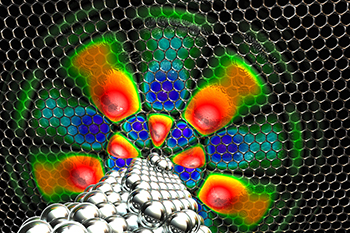
New quantum tool confines electrons. Credit: Jon Wyrick / NIST
Scientists have created the first nanometer-scale electronic analog of a classical whispering gallery in graphene that could have an impact in electron-based systems (Science, doi: 10.1126/science.aaa7469). Researchers at the U.S. National Institute of Standards and Technoogy (NIST) and physicists at the Massachusetts Institute of Technology (MIT, USA), took inspiration from the familiar phenomenon called whispering-gallery modes, in which sound waves are carried more efficiently around the circumference of a wall, like that of a dome or vault. Photons also exhibit the whispering-gallery effect, which have found use in lasing, ring resonators and modulators.
Graphene, a material that can be easily manufactured in one-atom-thick sheets with a honeycomb lattice structure, has potential in quantum electro-optic devices, because it has gate-tunable light-like carriers. The problem is that electrons in graphene and other solids have a short coherence length, which means they tend to tunnel ballistically through materials over micron distances. Yue Zhao at NIST exploited this property to create a whispering-gallery mode resonator defined by circular pn junctions induced by a scanning tunneling probe.
Zhao and colleagues placed a conductive plate below a sheet of graphene and positioned the probe tip above the graphene to create a local pn junction ring that can confine potential electronic states, and probe the electron tunneling at the same time. This created the whispering gallery, effectively a curved wall of mirrors that confines the electrons in a circular area. The electrons create interference waves that act like high-finesse resonator cavities that are fully tunable by varying the voltage at the probe tip, which could lead to electronic lenses and resonators.
“This electron resonator combines several good features,” says coauthor Leonid Levitov at MIT. “There’s clearly something special about having tunability and also high quality at the same time.”
Other contributors to the paper include scientists at the University of Maryland in College Park, Md., USA, Imperial College London, U.K., and the National Institute for Materials Science in Tsukuba, Japan.
